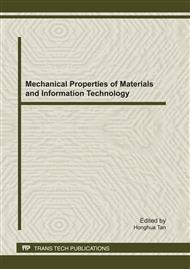[1]
Boyde A., Corsi A., Quarto R., Cancedda R., Bianco P. Osteoconduction in Large Macroporous Hydroxyapatite Ceramic Implants: Evidence for a Complementary Integration and Disintegration Mechanism. Bone, 1999, 24: 579-589.
DOI: 10.1016/s8756-3282(99)00083-6
Google Scholar
[2]
Muschler G. F, Nitto H, Matsukura Y, et al. Spine Fusion Using Cell Matrix Composites Enriched in Bone Marrow Derived Cells. Clin. Orthop., 2003, 407: 102–18.
DOI: 10.1097/00003086-200302000-00018
Google Scholar
[3]
Greenwald A. S, Boden S. D, Goldberg V. M, et al. Bone-Graft Substitutes: Facts, Fictions, and Applications. American Academy of Orthopedic Surgeons, 70th Annual Meeting, February 5-9; 2003. Instructional Course Lecture Handouts.
Google Scholar
[4]
Baker D.M. Benign Unicameral Bone Cyst: A Study of Forty-Five Cases with Long-term Follow Up. Clin. Orthop, 1970, 71: 140-151.
DOI: 10.1097/00003086-197007000-00018
Google Scholar
[5]
Boseker E.H., Bickel W.H., Dahlin D.C. A Clinicopathologic Study of Simple Unicameral Bone Cysts. Surg., Gyned. Und Obster., 1968, 127: 550-560.
Google Scholar
[6]
Krebs H., Daum R., Pflugfelder H., Roth F. J. Die juvenile Knochenzyste. Diagnostik, Therapie and Spategebrusse. Beitr. Klin. Chir., 1973, 220: 19-34.
Google Scholar
[7]
Neer C.S., Francis K.C., Johnston, A. D, Kiernan, H.A. Current Concepts on the Treatment of Solitary Unicameral Bone Cyst. Clin. Orthop., 1973, 97: 41-50.
DOI: 10.1097/00003086-197311000-00008
Google Scholar
[8]
Witt, A. N., Walcher, K., Zenker, H. Die Resektion sbehandlung rezidivierender juveniler Knochen cysten. Arch. f. Orthop. Unfall-Chir., 1972, 74: 105-115.
DOI: 10.1007/bf00416162
Google Scholar
[9]
Mahendra A., Maclean A.D. Available Biological Treatments for Complex Non-Unions. Injury, 2007, 38: 4-11.
DOI: 10.1016/s0020-1383(08)70004-4
Google Scholar
[10]
Sasso R. C, Williams J. I, Dimasi N, et al. Postoperative drains at the donor sites of iliac-crest bonegrafts. A prospective, randomized study of morbidity at the site in patients who had a traumatic injury of spine[J]. J Bone Joint Surg Am., 1998, 80: 631-635.
DOI: 10.2106/00004623-199805000-00003
Google Scholar
[11]
Bohner M. Resorbable Biomaterials as Bone Graft Substitutes. Materialstoday, 2010, 13: 24-30.
DOI: 10.1016/s1369-7021(10)70014-6
Google Scholar
[12]
Heini, P.F., Berlemann, U. Bone substitutes in Vertebroplasty. Eur Spine J., 2001, 10: 205-213.
Google Scholar
[13]
Vaccaro, A. R., Madigan, L. Spinal applications of biabsorbale implants. Orthopedics, 2002, 25: 1115-1120.
Google Scholar
[14]
Minamide A, Tamaki T, Yoshida M, et al. The Use of Sintered Bone in Spinal Surgery. J. Eur Spine., 2001, 10: 185-188.
Google Scholar
[15]
Bauer, T.W., Muschler, G. F. Bone graft materials : an overview of the basic science. Clin Orthop., 2000, 371: 10-19.
Google Scholar
[16]
Wenz, B. Analysis of the risk of transmitting bovine spongiform encephalopathy through bone grafts derived from bovine bone. Biomaterials, 2001, 22: 1599-1606.
DOI: 10.1016/s0142-9612(00)00312-4
Google Scholar
[17]
Dreesman H. Ueber knochenplombierung. Beitr Klin Chir., 1892, 9: 804–810.
Google Scholar
[18]
Wilkins R.M., Kelly C.M., Giusti D.E. Bioassayed Demineralized Bone Matrix and Calcium Sulfate: Use in Bone-Grafting procedures. Ann Chir Gynaeco., 1999, 188: 180–185.
Google Scholar
[19]
Gitelis S., Piasecki P., Turner T., et al: Use of a Calcium Sulfate-Based Bone Graft Substitute for Benignbone Lesions. Orthopedics, 2001, 24: 162–166.
DOI: 10.3928/0147-7447-20010201-19
Google Scholar
[20]
Peltier LF, Jones RH. Treatment of Unicameral Bonecysts by Curettage and Packing with Plaster-of-Parispellets. J Bone Joint Surg., 1978, 60A : 820–822.
DOI: 10.2106/00004623-197860060-00017
Google Scholar
[21]
Tay B. K, Patel V. V, Bradford DS. Calcium Ulfate-Calcium Phosphate-based Bone Substitutes: Mimicryof the Mineral Phase of Bone. Orthop Clin North Am. 1999, 30: 615–623.
DOI: 10.1016/s0030-5898(05)70114-0
Google Scholar
[22]
Brown W. E, Chow LC. A New Calcium Phosphate Setting Cement. J. Dent Res. 1983, 62: 672-677.
Google Scholar
[23]
Rzeszutek K. F., Sarraf J.E. Proton Pump Inhibitors Control Osteoclastic Resorption of Calcium Phosphate Implants and Stimulate Increased Local Reparative Bone Growth. J. Craniofac. Surge., 2003 , 14: 301-307.
DOI: 10.1097/00001665-200305000-00007
Google Scholar
[24]
Feed C. E, Vunjak-novakovic G., Iron K.J. Biodegradable Polymer Scaffolds for Tissue Engineering. Biotechnology, 1994, 12: 689-695.
Google Scholar


